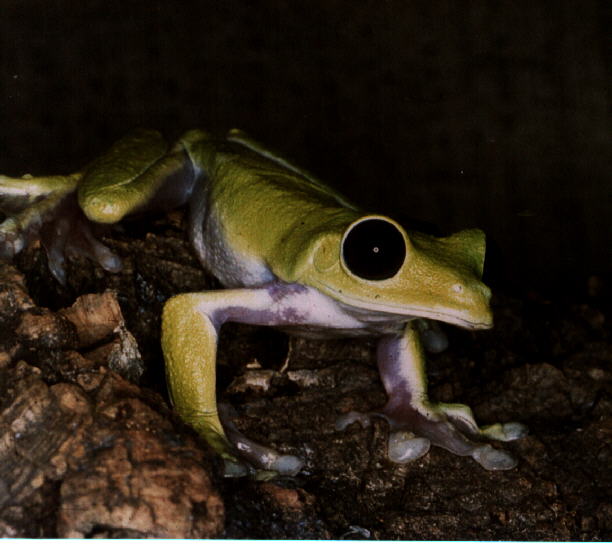Superregnum: Eukaryota
Regnum: Animalia
Subregnum: Eumetazoa
Cladus: Bilateria
Cladus: Nephrozoa
Superphylum: Deuterostomia
Phylum: Chordata
Cladus: Craniata
Subphylum: Vertebrata
Infraphylum: Gnathostomata
Superclassis: Tetrapoda
Classis: Amphibia
Subclassis: Lissamphibia
Ordo: Anura
Familia: Phyllomedusidae
Genus: Agalychnis
Species Agalychnis spurrelli
Name
Agalychnis spurrelli Boulenger, 1913
Type locality: "Peña Lisa, Condoto, altitude 300 feet", Provincia Chocó, Colombia.
Syntypes: BM 1947.2.24.24-25 (formerly 1913.11.12.129-130).
Synonyms
Agalychnis spurrelli Boulenger, 1913
Phyllomedusa spurrelli — Funkhouser, 1957
Phyllomedusa litodryas Duellman and Trueb, 1967
Agalychnis litodryas — Duellman, 1968
References
Boulenger, 1913, Proc. Zool. Soc. London, 1913: 1024.
Funkhouser, 1957, Occas. Pap. Nat. Hist. Mus. Stanford Univ., 5: 39.
Frost, D.R. 2021. Amphibian Species of the World: an Online Reference. Version 6.1. Electronic Database accessible at https://amphibiansoftheworld.amnh.org/index.php. American Museum of Natural History, New York, USA. DOI: 10.5531/db.vz.0001 Agalychnis spurrelli . Accessed on 30 Apr 2008.
2007 IUCN Red List of Threatened Species IUCN: Agalychnis spurrelli (Least Concern) Downloaded on 30 April 2008.
Vernacular names
English: Gliding Leaf Frog
The gliding tree frog (Agalychnis spurrelli) is a species of frog in family Phyllomedusidae. It is found in Colombia, Costa Rica, Ecuador, and Panama. Other common names are the gliding leaf frog, Spurrell's leaf frog, and pink-sided tree frog. The specific name, spurrelli, is in honour of British zoologist Herbert George Flaxman Spurrell.
Its natural habitats are subtropical or tropical moist lowland forests and intermittent freshwater marshes. It is threatened by habitat loss.
Description
The gliding tree frog grows to a snout to vent length of 48 to 56 mm (1.9 to 2.2 in) for males and 60 to 72 mm (2.4 to 2.8 in) for females. The head is broad and the eyes are large, with reticulated lower eyelids. The body is slim with smooth skin on the dorsal surface and limbs and granular skin on the belly. The limbs are slim and the fingers and toes have adhesive discs. The fingers are about three-quarter webbed and the toes fully webbed. The colour of the dorsal surface of this frog changes at nightfall from pale green to dark green. The underparts are cream and orange.[2]
Distribution
The gliding tree frog is native to the humid forests of south-eastern and south-western Costa Rica, Panama, the Pacific lowlands of Colombia, and north-western Ecuador.[1]
Biology
The gliding tree frog is a nocturnal species that lives in the tree canopy. It moves about by climbing using a hand-over-hand form of locomotion. It also glides while leaping which it does by spreading out its hands and feet when the extensive webbing acts as a parachute. It can maintain an angle of descent of up to 45° for some distance.[2]
Explosive breeding takes place in the rainy season. The eggs are laid in small clusters on the upperside of leaves overhanging temporary pools and water-filled cavities in logs. The eggs hatch in about six days and the tadpoles fall into the water below.[2]
References
IUCN SSC Amphibian Specialist Group (2020). "Agalychnis spurrelli". IUCN Red List of Threatened Species. 2020: e.T77651850A3028293. doi:10.2305/IUCN.UK.2020-3.RLTS.T77651850A3028293.en. Retrieved 16 November 2021.
Sarah Richman (2008-04-07). "Agalychnis spurrelli". AmphibiaWeb. Retrieved 2013-12-21.
Retrieved from "http://en.wikipedia.org/"
All text is available under the terms of the GNU Free Documentation License


